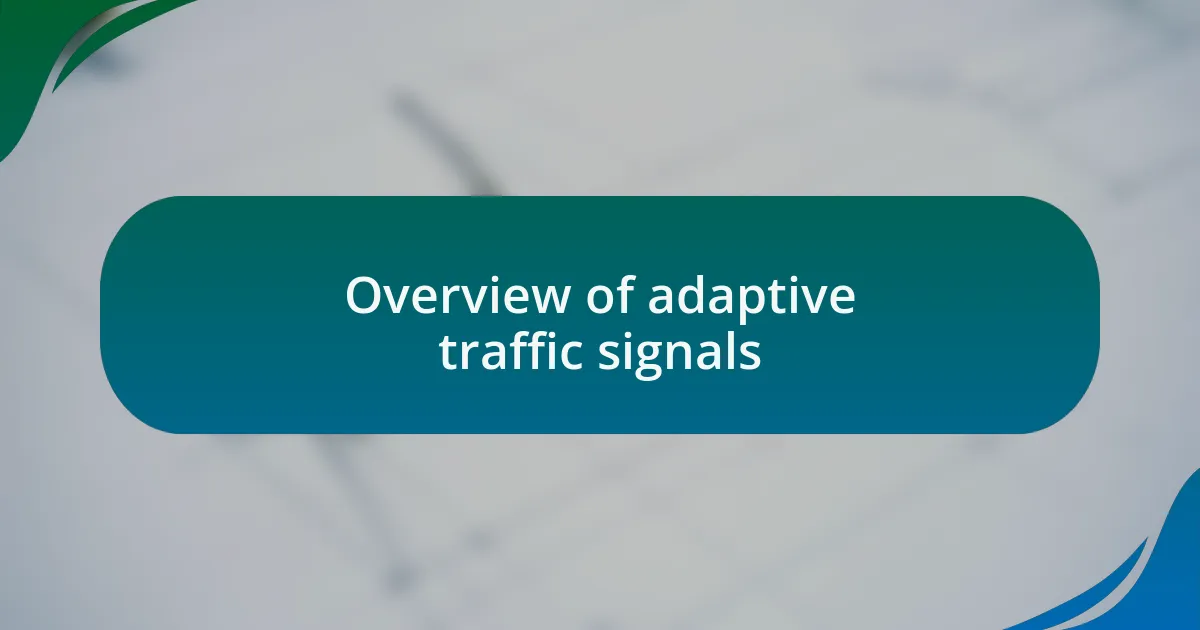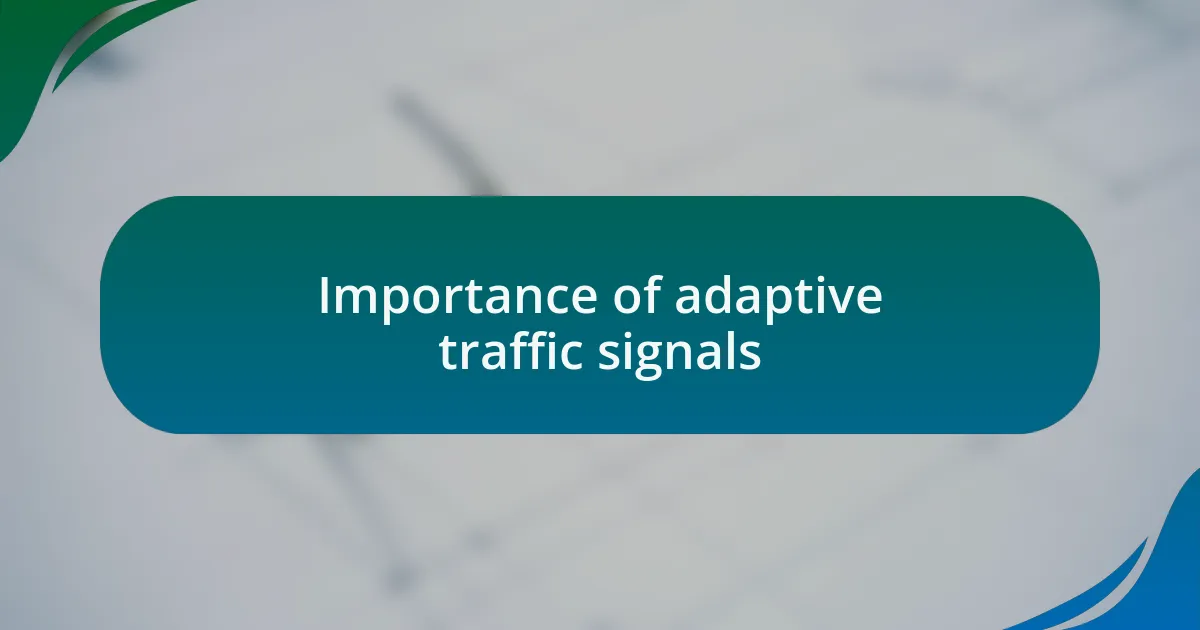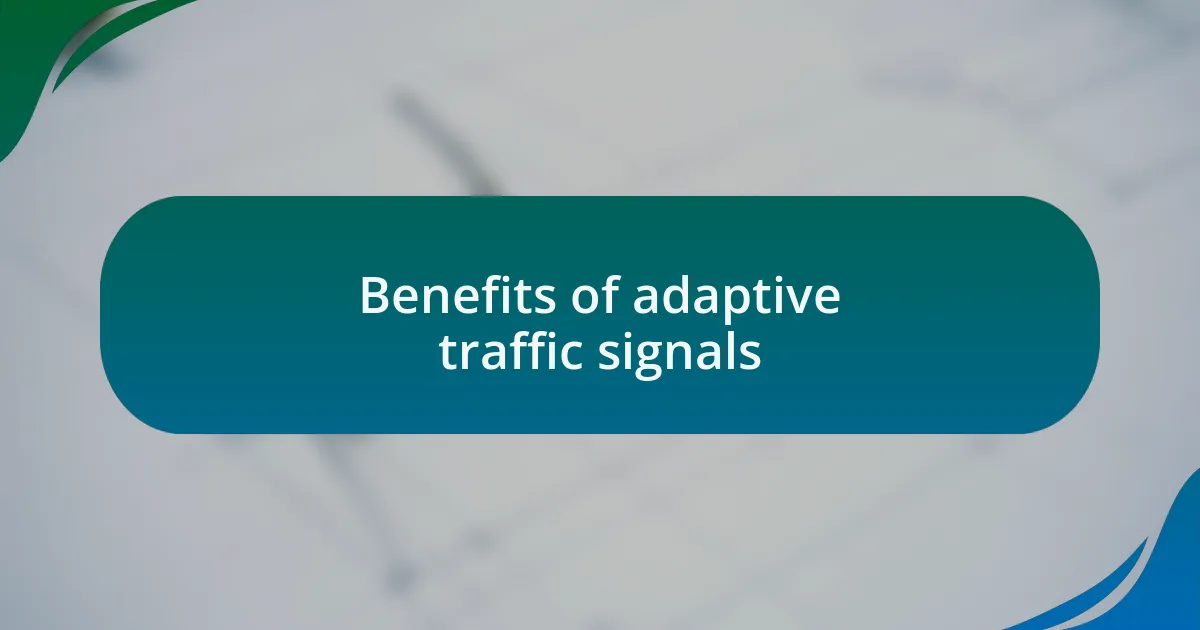Key takeaways:
- Adaptive traffic signals optimize traffic flow by using sensors and real-time data to adjust signal phases, enhancing urban safety and efficiency.
- Implementing adaptive signals reduces idle time at intersections, contributing to lower emissions and improved air quality.
- Real-world examples show that adaptive signals can significantly improve road safety, reduce congestion, and boost local economies.
- These systems foster a more organized traffic environment, making daily commutes smoother and safer for all road users, including pedestrians and cyclists.

Overview of adaptive traffic signals
Adaptive traffic signals are advanced systems designed to optimize traffic flow by responding in real-time to changing conditions on the road. I remember sitting in traffic one evening, frustrated as we inched forward. It struck me how reactive traffic signals could transform that experience by adjusting their timing based on vehicle cues, potentially alleviating not just congestion but also the collective anxiety that comes with it.
These signals utilize sensors and algorithms to process data continuously, adapting the signal phases accordingly. Imagine a scenario where a pedestrian is waiting to cross, and the system identifies their presence, adjusting the lights almost immediately to ensure safety. This responsiveness enhances not just efficiency but also the urban experience, connecting our daily lives with smarter infrastructure.
I often wonder how long it will take before adaptive signals become the norm in cities worldwide. In my interactions with urban planners, there’s a clear enthusiasm for technology that can create a more fluid and safer experience for all road users. As these signals evolve, I believe they have the potential to reshape our urban landscapes—fostering smoother traffic, reducing emissions, and ultimately promoting a sense of harmony in our bustling cities.

Importance of adaptive traffic signals
The importance of adaptive traffic signals cannot be understated, especially considering their impact on overall urban efficiency. I recall a particularly hectic morning where I witnessed a bus getting stuck at a red light, while side streets were virtually empty. With adaptive signals, that bus could have been prioritized, ensuring that public transportation runs smoothly and punctually—an essential aspect of a well-functioning urban system.
From my observation, these signals significantly reduce idle time at intersections, which is a huge win for both commuters and the environment. I often think about the air quality in my city, and it’s eye-opening to realize that less time spent idling means fewer emissions. Isn’t it fascinating how a technology designed for traffic can also contribute to bettering our environment and health in the long run?
I can’t help but reflect on the broader implications of implementing adaptive traffic systems. Imagine neighborhoods where children can safely cross streets without delays, or cyclists having a smoother ride amid the hustle of city life. It feels heartening to think of a future where adaptive technology plays such a pivotal role in shaping our urban experiences and enhancing community well-being.

Benefits of adaptive traffic signals
One of the profound benefits of adaptive traffic signals is their ability to enhance road safety. I vividly recall a time when a pedestrian was waiting far too long to cross at a busy intersection, feeling anxious and unsure. With adaptive signals, we could ensure they receive the green light promptly, minimizing potentially dangerous situations. Isn’t it reassuring to know that technology can help protect vulnerable road users?
Moreover, traffic flow becomes much more efficient with the integration of adaptive signals. I often drive through a particularly congested area and remember how frustrating it was to be caught in a sea of red lights, watching the clock tick away. With adaptive technology, the signals respond in real-time to traffic conditions, reducing overall wait times. Can you imagine the relief of finally cruising smoothly through those intersections instead of being stalled in endless gridlock?
In my experience, the economic impact is another compelling advantage. Businesses along major streets can thrive when traffic flows freely. I once visited a café that struggled with sales due to constant congestion outside. After the city implemented adaptive signals, foot traffic increased remarkably, leading to revitalized local commerce. It’s incredible how a smart traffic management system can usher in both convenience and economic benefits for a community.

Real-world examples of effectiveness
When I think about real-world examples of adaptive traffic signals, one case stands out in my memory: a busy intersection in downtown. After the city installed the system, I noted a significant reduction in backup; it was incredible to drive through without the usual frustration. How often do we find ourselves stuck at a light when no one is around? With adaptive signals, I felt like the city was actually working for the people, not just against them.
Another undeniable success story comes from a suburban neighborhood where I used to live. The local government decided to implement adaptive traffic signals to manage school drop-off times. I remember watching the chaos of parents dropping off kids turn into an organized flow, drastically improving safety. Wasn’t it a relief to see the morning rush transform into something more manageable? I truly believe these systems can redefine how communities engage with traffic.
In a larger urban setting, I recently read about a city that saw a dramatic decrease in accident rates after introducing adaptive signals. As a frequent driver in that area, I felt a newfound sense of comfort. Knowing that technology was actively working to enhance safety made all the difference; it felt personal. Isn’t it fascinating to witness how a shift in technology can reshape our everyday experiences on the road?